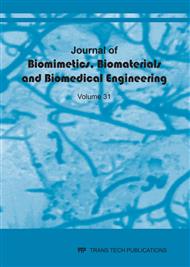[1]
S. Cuzzocrea, B. Zingarelli, P. Hake, A.L. Salzman, C. Szabó, Antiinflammatory effects of mercaptoethylguanidine, a combined inhibitor of nitric oxide synthase and peroxynitrite scavenger, in carrageenan-induced models of inflammation, Free Radical Biology and Medicine 24 (1998).
DOI: 10.1016/s0891-5849(97)00280-3
Google Scholar
[2]
R. Di Paola, S. Marzocco, E. Mazzon, F. Dattola, F. Rotondo, D. Britti, M. De Majo, T. Genovese, S. Cuzzocrea, Effect of aminoguanidine in ligature-induced periodontitis in rats, Journal of Dental Research (83) 2004 343–348.
DOI: 10.1177/154405910408300414
Google Scholar
[3]
G.J. Southan, C. Szabó, Selective pharmacological inhibition of distinct nitric oxide synthase isoforms, Biochemical Pharmacology 51(1996) 383–394.
DOI: 10.1016/0006-2952(95)02099-3
Google Scholar
[4]
Z. Lohinai, P. Benedek, E. Fehér, A. Györfi, L. Rosivall, A. Fazekas, A.L. Salzman, C. Szabó, Protective effects of mercaptoethylguanidine, a selective inhibitor of inducible nitric oxide synthase, in ligature-induced periodontitis in the rat, British Journal of Pharmacology 123(1998).
DOI: 10.1038/sj.bjp.0701604
Google Scholar
[5]
R.P. Allaker, L.S. Silva Mendez, J.M. Hardie, N. Benjamin, Antimicrobial effect of acidified nitrite on periodontal bacteria, Oral Microbiology and Immunology 16 (2001) 253-256.
DOI: 10.1034/j.1399-302x.2001.160410.x
Google Scholar
[6]
S. Carossa, P. Pera, P. Doglio, S. Lombardo, P. Colagrande, L. Brussino, Oral nitric oxide during plaque deposition, European Journalof Clinical Investigation 31(2001) 876-879.
DOI: 10.1046/j.1365-2362.2001.00902.x
Google Scholar
[7]
A.W. Carpenter, M.H. Schoenfisch, Nitric oxide release: Part II. Therapeutic applications, Chemical Society Reviews 41(2012) 3742-3752.
DOI: 10.1039/c2cs15273h
Google Scholar
[8]
P.N. Coneski, M.H. Schoenfisch, Nitric oxide release: Part III. Measurement and reporting, Chemical Society Reviews 41 (2012) 3753-3758.
DOI: 10.1039/c2cs15271a
Google Scholar
[9]
L.A. Chambrone, L. Chambrone, Tooth loss in well-maintained patients with chronic periodontitis during long-term supportive therapy in Brazil, Journal of Clinical Periodontology 33 (2006) 759–764.
DOI: 10.1111/j.1600-051x.2006.00972.x
Google Scholar
[10]
M. A. Botelho, V.S. Rao, C.B. Carvalho, J.G. Bezerra-Filho, S.G. Fonseca, M.L. Vale, D. Montenegro, F. Cunha, R.A. Ribeiro, G.A. Brito, Lippia sidoides and Myracrodruon urundeuva gel prevents alveolar bone resorption in experimental periodontitis in rats, Journal of Ethnopharmacology 113(2007).
DOI: 10.1016/j.jep.2007.07.010
Google Scholar
[11]
A.M. Menezes, F.A. Rocha, H.V. Chaves, C.B. Carvalho, R.A. Ribeiro, G.A. Brito, Effect of sodium alendronate on alveolar bone resorption in experimental periodontitis in rats, Journal of Periodontology 76 (2005) 1901–(1909).
DOI: 10.1902/jop.2005.76.11.1901
Google Scholar
[12]
B.J. Zimmerman, M.B. Grisham, D.N. Granger, Role of oxidants in ischemia/reperfusion-induced granulocyte infiltration, American Journal of Physiology 258(1990) 185–190.
DOI: 10.1152/ajpgi.1990.258.2.g185
Google Scholar
[13]
G.W. Sullivan, I.J. Sarembock, J. Linden The role of inflammation in vascular diseases, Journal of Leukocyte Biology 67(2000) 591–602.
DOI: 10.1002/jlb.67.5.591
Google Scholar
[14]
S.O. Iseri, G. Sener, M. Yüksel, G. Contuk, S. Cetinel, N. Gedik, B.C. Yegen, Ghrelin against alendronate-induced gastric damage in rats, Journal of Endocrinology 187(2005) 399–406.
DOI: 10.1677/joe.1.06432
Google Scholar
[15]
S.A. Holanda Pinto, L.M. Pinto, G.M. Cunha, M.H. Chaves, F.A. Santos, V.S. Rao Anti-inflammatory effect of alpha, beta-Amyrin, a pentacyclic triterpene from Protium heptaphyllum in rat model of acute periodontitis, Inflammopharmacology 16(2008).
DOI: 10.1007/s10787-007-1609-x
Google Scholar
[16]
M. A. Botelho, V.S. Rao, C.B. Carvalho, J.G. Bezerra-Filho, S.G. Fonseca, M.L. Vale, D. Montenegro, F. Cunha, R.A. Ribeiro, G.A. Brito, Lippia sidoides and Myracrodruon urundeuva gel prevents alveolar bone resorption in experimental periodontitis in rats, Journal of Ethnopharmacology 113 (2007).
DOI: 10.1016/j.jep.2007.07.010
Google Scholar
[17]
Ö. Fentoglu, F.Y. Kırzıoglu, M.T. Bulut, D. Kumbul Doguc, E. Kulac, C Önder, M. Günhan, Evaluation of lipid peroxidation and oxidative DNA damage in patients with periodontitis and hyperlipidemia, Journal of Periodontology 86 (2015) 682–688.
DOI: 10.1902/jop.2015.140561
Google Scholar
[18]
Y.S. Kim, S.J. Kang, J.W. Kim, H.R. Cho, S.B. Moon, K.Y. Kim, H.S. Lee, C.H. Han, S.K. Ku, Y.J. Lee, Effects of Polycan, a β-glucan, on experimental periodontitis and alveolar bone loss in Sprague-Dawley rats, Journal of Periodontal Research 47 (2012).
DOI: 10.1111/j.1600-0765.2012.01502.x
Google Scholar
[19]
S.K. Ku, H.R. Cho, Y.S. Sung, S.J. Kang, Y.J. Lee, Effects of calcium gluconate on experimental periodontitis and alveolar bone loss in rats, Basic and Clinical Pharmacology and Toxicology 108 (2011) 241–250.
DOI: 10.1111/j.1742-7843.2010.00646.x
Google Scholar
[20]
H. Toker, H. Ozdemir, K. Eren, H. Ozer, G. Sahin, N-acetylcysteine, a thiol antioxidant, decreases alveolar bone loss in experimental periodontitis in rats, Journal of Periodontology 80 (2009) 672–678.
DOI: 10.1902/jop.2009.080509
Google Scholar
[21]
J.H. Park, B.I. Seo, S.Y. Cho, K.R. Park, S.H. Choi, C.K. Han, C.H. Song, S.J. Park, S.K. Ku, Single oral dose toxicity study of prebrewed armeniacae semen in rats, Toxicology Research 29 (2013) 91–98.
DOI: 10.5487/tr.2013.29.2.091
Google Scholar
[22]
M. Hatipoglu, N.Ö. Alptekin, M.C. Avunduk, Effects of alpha-tocopherol on gingival expression of inducible nitric oxide synthase in the rats with experimental periodontitis and diabetes, Nigerian Journal of Clinical Practice 4 (2016) 480-485.
DOI: 10.4103/1119-3077.183301
Google Scholar
[23]
D. V. Srubilin, D. A. Enikeev, V. A. Myshkin, Role of the nitroxidergic system at the regulation of oxidative stress in rats' gingiva with experimental periodontitis, Fundamental studies 10-4 (2014) 724– 731.
Google Scholar
[24]
F. Cosentino, J. Sill, Z. Kanusle, Role of superoxide anion in the mediation of endothelium-dependent contraction, Hypertension 5 (2014) 229 –235.
Google Scholar
[25]
W.T. Clements., Le Sang-Rok, J. R. Bloomer, Nitrate Ingestion: A Review of the Health and Physical Performance aorta effects, Nutrients 11(2014) 5224–5264.
DOI: 10.3390/nu6115224
Google Scholar
[26]
S. Lidder, A.J. Webb, Vascular effects of dietary nitrate (as found in green leafy vegetables and beetroot) via the nitrate-nitrite-nitric oxide pathway, Journal Clinical Pharmacology 4 (2013) 267– 275.
DOI: 10.1111/j.1365-2125.2012.04420.x
Google Scholar


